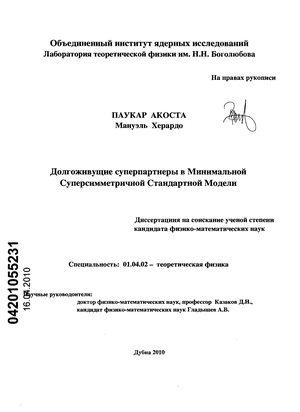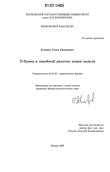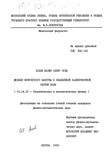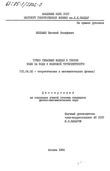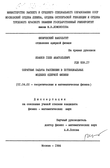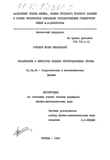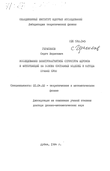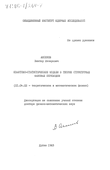Содержание к диссертации
Введение
2 Supersymmetry and the Supersymmetric Extension of the Standard Model 5
2.1 Supersymmetry 7
2.2 MSSM 9
2.2.1 Structure of the MSSM 10
2.3 Minimal Supergravity 14
2.4 The mSUGRA Sparticle Spectrum 19
2.4.1 Squarks and Sleptons 19
2.4.2 Neutralinos and Charginos 21
2.4.3 A Sample of mSUGRA Sparticle Spectrum 22
3 Favoured Regions of mSUGRA Parameter Space 25
3.1 Theoretical and Experimental Constraints 26
3.2 (mo-mi/2) Plane of Parameters Space 30
3.2.1 Favoured Parameter Regions 30
3.2.2 The case for Non-zero A0 35
4 mSUGRA Co-annihilation Region and Long-lived Charged Sleptons 39
4.1 The (x?-r) Co-annihilation Region -motivations for Long-lived Spartides 41
4.2 Long-lived r Charged Sparticle 43
4.3 Production Cross Section of Long-lived r Charged Sparticle at LHC . 47
4.4 Discussion 51
5 Light Scalar top quarks 52
5.1 The Light Stop Scenario -Long-lived Scalar top quarks 53
5.2 Phenomenological Consequences of the Light Stop Scenario 58
5.2.1 Stop decay modes and lifetime 59
5.3 Discussion 63
6 Long-lived Charginos in the Focus Point Region 64
6.1 The Focus Point Region of mSUGRA Parameter Space 65
6.2 Phenomenological consequences of the light Chargino 73
6.3 Discussion 79
Conclusions 81
Bibliography 84
List of Tables 101
List of Figures 102
Acknowledgements 106
- Minimal Supergravity
- Favoured Parameter Regions
- Long-lived r Charged Sparticle
- Phenomenological Consequences of the Light Stop Scenario
Введение к работе
Объект исследования и актуальность темы
Несмотря на то, что в настоящее время Стандартная Моделв успешно используется для описания электромагнитных, слабых и сильных взаимодействий, новая физика, по мнению многих ученых, может проявить себя при энергиях около 1 ТэВ. Суперсимметрия рассматривается как наиболее перспективное направление физики элементарных частиц за пределами Стандартной Модели. Поиск новой физики является одной из основных задач экспериментальных исследований на Большом Адронном Коллайдере (LHC).
Надежды на открытие суперсимметрии на LHC основаны на предсказаниях Минимальной Суперсимметричной Стандартной Модели (МССМ), при этом подразумевается широкий спектр различных возможностей и, в то же время, неопределенностей. Обычно считается, что суперпартнеры — гипотетические тяжелые частицы с массой несколько сотен ГэВ, определяемой значениями параметров мягкого нарушения суперсимметрии то, mi/2, А0 — рождаются за счет сильного и слабого взаимодействий и живут очень недолго. Практически сразу же после рождения они распадаются на обычные частицы Стандартной Модели и легчайшую суперчастицу — нейтралино. Очевидно, что наблюдение таких короткоживущих частиц достаточно затруднено.
Однако, возможна ситуация, реализуемая в рамках Минимальной суперсимметричной Стандартной Модели с нарушением суперсимметрии за счет эффектов гравитации (так называемая модель mSUGRA), когда суперчастицы живут долго. Это происходит, когда масса суперчастицы очень близка к массе легчайшей суперчастицы (the Lightest Supersymmetric Particle - LSP), и скорость распада, таким образом, подавляется. В этом случае долгоживущими могут быть так называемые следующие за легчайшими суперсимметричные частицы (Next-to-Lightest Supersymmetric Particles - NLSP) — это могут быть суперпартнеры тау-лептона, топ-кварка и заряженного бозона Хиггса (или W-бозона), при этом легчайшей суперчастицей является первое нейтралино.
На рис. 1 показаны области пространства параметров модели mSUGRA, где может иметь место указанное вырождение по массе, и, следовательно, могут существовать долгоживущие суперчастицы. На границах этих областей, когда массы суперпартнеров практически равны массе легчайшего нейтралино, тау-слептоны, топ-скварки и чарджино становятся долгоживущими. При удалении от границы суперпартнеры становятся слегка тяжелее, чем нейтралино, что приводит к их нестабильности, и они очень быстро распадаются.
Одним из наиболее важных ограничений на допустимые значения параметров mSUGRA является количество темной материи во Вселенной. Принимая во внимание данные эксперимента WMAP, получаем в результате разрешенную область в виде узкой полосы, идущей вдоль границы (запрещенной) области, где легчайшей суперчастицей является тау-слептон, затем вдоль границы области, исключенной ненаблюдением легкого бозона Хиггса, и вдоль границы области, в которой не происходит радиационного нарушения электрослабой симметрии (Radiative electroweak symmetry breaking - REWSB). Вдоль этой узкой полосы, где необходимое количество темной материи Q^oh2 согласуется с астрофизическими
m0 [GeV] m0 [GeV]
Рис. 1: Разрешеннвіе области пространства параметров в плоскости (то — mi/2) при А0 = О, tan/З = 10 (слева), А0 = —800 ГэВ, tan/З = 10 (справа), /і > 0 и 77=172.7 ГэВ. Узкая светлая полоса в темно-желтой области — разрешенная область, соответствующая космологическим ограничениям WMAP. На рисунке от-мечены: 1 - Основная областв аннигиляции; 2 - Область коаннигиляции; 3 - Область фокус-точки; 4 - Область "воронки"; 5 - Область EGRET; 6 - область долгоживущих топ-скварков. Показанві эксперименталвные ограничения на массві бозона Хиггса и чарджино, а также на области, где тау-слептон, топ-скварк и чарджино являются следующими за легчайшими суперчастицами (NLSP).
наблюдениями WMAP, предполагая, что темная материя состоит из нейтралино, существует три представляющих интерес области пространства параметров, где существуют долгоживущие суперпартнерві:
г) Область легких тау-слептонов, являющихся NLSP (х? —т). Область характеризуется параметрами ra\ji » то, значения других параметров практически несущественны. Данная область с долгоживущими тау-слептонами представляет собой узкую полосу вдолв границы, разделяющих области, в которых легчайшими суперчастицами являются нейтралино и тау-слептон, соответственно.
и) Областв легких топ-скварков, являющихся NLSP (х? — t). Данная область существует при болвших отрицателвных значениях Aq, промежуточных и больших значениях то, малых значениях mi/2, tan/3 > 10 и ц > 0. Область долгоживущих суперпартнеров топ-кварков находится практически на краю основной области аннигиляции рядом с линией ограничения на массу бозона Хиггса.
гіг) Область легких чарджино, являющихся NLSP (х? — Xi)- Для существования этой области также необходимы большие отрицательные значения Aq. Значения других параметров rrii/2 << то, /J. > 0, и чем больше значение tan/З, тем лучше. Область долгоживущих чарджино прилегает к линии, ниже которой не происходит радиационного нарушения электрослабой симметрии, и фактически совпадает с областью фокус-точки.
Изучение феноменологических следствий суперсимметричнвіх теорий сегодня очень актуально, так как начал работу Большой Адронный Коллайдер (Large Hadron Collider - LHC). Исследование процессов в рамках вышеуказанных сценариев сейчас представляет большой интерес, поскольку первые физические результаты на LHC ожидаются в самом ближайшем будущем. Интересующие нас легкие
долгоживущие частицы — тау-слептоны, топ-скварки и чарджино могут быть получены уже в самые первые месяцы работы коллайдера.
В связи с тем, что тау-слептоны, топ-скварки и чарджино относительно легкие в нашем сценарии, сечения их рождения достаточно большие и могут достигать несколько процентов пикобарн для парного рождения тау-слептонов и чарджино и даже сотни пикобарн для парного рождения топ-скварков, если они достаточно легкие rnq < 150 ГэВ. С ростом массы топ-скварков, сечение рождения быстро падает. Однако, даже для очень больших отрицательных значений Aq, когда топ-скварки становятся тяжелее нескольких сотен ГэВ, сечение рождения все равно имеет порядок нескольких процентов пб, что достаточно для их обнаружения при высокой светимости ГНС.
Родившись, тау-слептоны, топ-скварки и чарджино распадаются на частицы Стандартной Модели и легчайшее нейтралино. Единственная разрешенная мода распада для тау-слептона — это распад на тау-лептон и нейтралино. Топ-скварки имеют несколько возможных мод распада в зависимости от их массы. Если топ-скварк достаточно тяжелый, то тогда возможен распад на Ь-кварк и легчайшее чарджино. Однако, в интересующей нас области при больших отрицательных значениях Aq, а именно Aq < —1500 ГэВ, область пространства параметров, где возможна данная мода распада, становится меньше и даже исчезает из-за неравенства vrij < тпъ + ^y±- В этом случае наиболее вероятная мода распада — это распад на t-кварк и легчайшее нейтралино. Достаточно легкий топ-скварк распадается на с-кварк и легчайшее нейтралино. Последний распад, несмотря на то, что может происходить только на петлевом уровне, имеет вероятность 100 %. В случае чарджино основные процессы распада — это распад на пару кварков и легчайшее нейтралино, или на лептон, соответствующее нейтрино и легчайшее нейтралино. Относительная вероятность распада для кварковых конечных состояний составляет около 74 %, а для лептонных конечных состояний 26 %. Наблюдаемые события будут иметь необычную сигнатуру и должны проявиться в виде заметного сигнала, а не просто недостающей энергии, унесенной легчайшим стабильным нерегистрируемым нейтралино.
Цель работы
Изучение возможности существования долгоживущих суперпартнеров в рамках Минимальной Суперсимметричной Стандартной Модели с нарушением суперсимметрии за счет эффектов гравитации и универсальными начальными условиями для параметров мягкого нарушения суперсимметрии.
Исследование феноменологических следствий сценариев с долгоживущими суперчастицами, в частности предсказание сечений рождения и изучение различных мод распада на Большом Адронном Коллайдере.
Научная новизна и практическая ценность
Научная новизна настоящей работы заключается в том, что в рамках Минимальной Суперсимметричной Стандартной Модели (МССМ) с механизмом нарушения суперсимметрии за счет эффектов гравитации и универсальными начальными условиями для параметров мягкого нарушения суперсимметрии на масштабе Великого объединения продемонстрирована возможность существования
следующих за легчайшими суперчастиц (NLSP) — долгоживущих суперпартнеров тау-лептонов, топ-кварков и заряженных бозонов Хиггса (или ГУ-бозонов) и возможность того, что такие долгоживущие суперпартнеры могут быть получены и зарегистрированы в экспериментах на Большом Адронном Коллайдере.
Показано, что существует три области пространства параметров в модели минимальной супергравитации (mSUGRA), где могут существовать такие долгоживущие суперпартнеры. Таким образом, могут быть рассмотрены три важных сценария: сценарий с легкими тау-слептонами, являющимися NLSP, сценарий с легкими топ-скварками, являющимися NLSP, и сценарий с легкими чарджино. Каждый из этих сценариев не противоречит теоретическим и экспериментальным ограничениям, накладываемым на значения параметров, в частности, ограничению на количество темной материи (ограничению WMAP).
События распада долгоживущих частиц имеют необычную сигнатуру: г) частицы либо пролетают сквозь детектор, либо и) распадаются внутри него с образованием вторичной вершины. Оба случая приводят к заметному сигналу, а не просто характеризуются недостающей энергией, уносимой легчайшим стабильным нейтралино.
В сценарии с долгоживущим еоп-скварком возможно также образование так называемых і?-адронов (связанных состояний суперсимметричных частиц) в случае, если время жизни топ-скварков больше времени адронизации.
Апробация работы
Материалы диссертации докладывались на конференциях и семинарах:
IX Международной Московской школе по физике (33 зимней школе ИТЭФ), 21 февраля - 1 марта 2006 г., Москва.
XV Международной конференции по суперсимметрии и объединению фундаментальных взаимодействий (SUSY '07), 26 июля - 1 августа 2007 г., Карлсруэ, Германия.
XV Международном семинаре по физике высоких энергий (QUARKS '08), 23-29 мая 2008г., Сергиев Посад.
Семинаре Квантовая теория поля Лаборатории теоретической физики им. Н.Н. Боголюбова Долгоживущие чарджино в области фокус-точки пространства параметров МССМ, 2 июля 2008г., Дубна.
III Международной конференции Структура адронов '09, 30 августа - 3 сентября 2009 г., Татранска Штрба, Словакия.
Семинаре Квантовая теория поля Лаборатории теоретической физики им. Н.Н. Боголюбова Долгоживущие суперпартнеры в Минимальной Суперсимметричной Стандартной Модели, 2 сентября 2009 г., Дубна.
Публикации по материалам диссертации
Диссертация написана на основании содержания б работ.
Структура и объем диссертации
Диссертация состоит из семи глав. Общий объем диссертации составляет 106 страниц машинописного текста, включая 21 рисункок, 7 таблиц и список литературы из 140 наименования.
Minimal Supergravity
The advantage of the MSSM is that it represents the most general case of the minimal low energy supersymmetric model and is both of theoretical while the second one represents the soft SUSY breaking which has the same group of symmetries as the SUSY lagrangian, but without SUSY. and phenomenological interest [55]. However, as what can be seen from Eqs. (2.2) and (2.7), the MSSM has a large number of new parameters, which has no counterpart in the SM. Many of them come from the soft breaking lagrangian. Exact counting shows that it contains at least 105 new physical parameters (masses, phases and mixing angles) [39] in addition to the SM parameters. To be specific, 104 are from Csoft, and only, tan/3, is from CSUSY- Therefore, the advantage of the MSSM is more or less diluted by this large number of parameters. To reduce this parameter freedom the simplest way is to take the MSSM as the effective low energy theory of an underlying theory which has simpler structure at high energy. A large amount of work has been done in this direction and many models have been proposed. Here we concentrate on supergravity models [1, 56, 57, 58], especially the minimal one, i.e. the minimal supergravity model or mSUGRA [4, 59, 60, 61, 62, 63, 64]. Supergravity incorporates gravity into the theory by requiring Super-symmetry to be locally invariant6. From the graded Lie algebra in Eq. (2.1) it can be inferred that invariance under local SUSY transformations7 implies invariance under local coordinate change, which is the underlying principle of general relativity.
Thus, local SUSY naturally includes gravity or rather supergravity. The full Lagrangian of the theory with unbroken supersymmetry can be constructed systematically (for details see ref. [66, 57]). For phenomenological analysis it is good enough to take the limit of infinite planck scale (i.e. the flat limit) which simplifies the Lagrangian to a form similar to that of the MSSM. The final structure strongly depends on the SUSY breaking mechanism since in the unbroken case symmetries can determine the structure. One phenomenologically acceptable SUSY breaking mechanism is to first break SUSY in a hidden sector and then communicate the breaking to the physical sector (where physical fields such as leptons, quarks, Higgs and their superpartners reside) by gravity. mSUGRA discussed below is the minimal picture of this model. In mSUGRA, at the GUT scale8, MQUT, the parameters of the soft breaking terms include a universal scalar mass mo, a universal gaugino mass 7ТІ1/2 and universal trilinear scalar term AQ, corresponding to setting the following in Eq. (2.7); Then we are left with 5 parameters (one can see that in Eq. (2.7) there are two more parameters, В and /І). One can further require that the electroweak symmetry breaks radiatively (REWSB) to eliminate one more parameter. At the tree level, this requirement will give, at the electroweak І? = " я, " .— " _ ±га (2.11) here tan/? = H2 I ne га between the vacuum expectation values (VEV s) of H2 and Яь Eq. (2.11) shows that fi2 can be traded for tan/3 and then В can be eliminated. Notice that the sign of /І cannot be determined by Eq. (2.11) and needs to be specified at the weak scale. (In conventional mSUGRA, the soft breaking terms are assumed real).
Therefore, we have four new parameters space and a sign (or J +l parameters space) in addition to the SM parameters, In addition, when imparity conservation is assumed, the superpotential in the mSUGRA model is the same as the MSSM one given in Eq. (2.2). The studies of the mSUGRA model usually start with a set of parameters at MQUT arid then run the renormalization group equations (RGEs) [67, 68, 69, 70, 71] down to the Electroweak scale, Mw, as illustrated in Fig. (2.1). The SM parameters in many cases can be taken from the results of their SM fits at least as good approximations. In some cases, SUSY corrections are significant and thus have to be taken into account, e.g. SUSY corrections to the Higgs mass [72, 73] and the mass of the bottom quark, m& [74, 75]. Finally, compared with the general MSSM with more than 100 new parameters, the mSUGRA model, i.e the MSSM with gravity mediated SUSY breaking and the universal soft terms has a much higher predictive power. The mSUGRA Spectrum9 can be deduced through a standard procedure from the various particles mass matrices originating from the superposition of all the contributions appearing in the Lagrange terms which have been collected in Eq. (2.7). We will discuss here each of the groups of the Sparicles spectrum, focusing on the third generation of Sfermions important for this thesis. As already mentioned every SM fermion f has two superpartners (or Sfermions) with spin 0 denoted by fi, and /R one for each chiral state. There is no VR in mSUGRA model. In general fi and /д are not the mass eigenstates, since there is /L-/R mixing proportional in strength to the corresponding element of the scalar squared mass matrix [41, 50]. In principle, any Sfermions with the same electric charge, R-parity and colour quantum number can mix. We list in Table (2.2) all Sfermions indicating both the interaction and mass eigenstates. There are three contributions to the running of Sfermions masses: the gaugino coupling, the Yukawa coupling and the trilinear interactions. 9 We will not perform a RGEs analysis here, for our purpose it is sufficient to say simply that one can determine these equations, integrate them via numerical methods and thus arrive at a description of the mass spectrum for the Sparticles at the Ew- The SUSY Spectrum codes we used for such purposes are described in the next chapter.
Favoured Parameter Regions
In our analysis, we have generated the My/ Sparticle spectrum from the input parameters at the MQUT by using the Fortran code SuSpect [103] . This code employs the two-loop RGEs and implements the REWSB mechanism. We have used the code MicrOmegas [104, 105] for computing the neutralino relic density. We have included LEP2 and Tevatron lower limits for superpartner masses and set top quark mass, mt = 172.7 GeV. We have also performed a detailed analysis of the mSUGRA parameters with another code as ISASUGRA/ISAJET [106] 2. In our numerical analysis we follow the procedure outlined in Chapter 2: we fix the mSUGRA parameters A$ as well as tan/3 (which is given at M\y) and the sign of fi (which is positive to comply the a = (g — 2)/2 constraint) and then perform a scan over the high energy mSUGRA inputs TUQ and mi/2- From these boundary conditions, all the soft breaking parameters and couplings evolve down to the M\y using the RGE s (see Fig. (2.1)). The resulting spectrum has to pass the above-cited constraints before being accepted as a possible description of Nature. Our first results are plotted in Fig. (3.1). Here, we show qualitatively the (mo — ГП1/2) plane for AQ=0, \I 0 and tan/3—10, 50 (a and 6), parameters mo and mi/2 are kept free. The light gray dense regions are excluded either due to « ) a lightest superpartner that is not the lightest neutralino Xi, or ii) a lack of appropriate REWSB. The region below the red contour has a lightest Higgs mass m o 114.4 GeV in apparent discord with recent results from LEP2 on searches for SM Higgs bosons. The region below the blue contour is excluded by searches for charginos and Sleptons at LEP2. In addition, we show regions of neutralino relic density with dark yellow contour labelled Q oh2. One can see the narrow Qjgh2 band indicating the only allowed region, where the right amount of dark matter is consistent with WMAP astrophysical observations. Along this band, different parameter regions are labelled by numbers, and in all these parameter regions the present experimental constraints are fulfilled. Consider several different mSUGRA parameter regions along the Q o/i2 band where qualitatively distinct mechanisms lead to Xi dark matter with found in the literature [107, 108, 109], while a detailed comparison for various codes can be found in Refs. [110, 111, 112]. the desired relic density [113, 114, 115, 116]:
The Bulk annihilation region or the Bulk region in the mSUGRA model is characterized by low values of TTIQ and 7711/2 In the bulk region, Sfermion masses are sufficiently small to allow a large creff, which implies an acceptable small Q oh2. The x -LSP in this case is mostly Bino-like that annihilates via light Sfermions exchange in the i-channel. One of the main processes in this region is XiXi ЯЯ As we see from Fig. (3.1) the Bulk region is largely excluded by the LEP2 Higgs mass bound, m/to 114.4 GeV. In this region the lightest Higgs boson tends to be too light, m p « 110,112 GeV. This allowed region in the (mo-rai/2) plane appears at moderate values of mo and mi/2 and occurs only for large tan/3 (tan/3 40), see Fig. (3.1) (6). In this region the bino x -LSP annihilates via heavy Higgs boson A exchange in the s-channel. This process is efficient when 2m o « тл=Ы\4, Г 10 — 50 GeV. The main process in this region is XiXi b (or X?X?- TT). The A resonance occurs when 2m o = тл- The A resonance region may be broad, extending the region of parameters space over which this process is important. The A resonance produces reduction on the neutralino relic density. So, the desired relic density is obtained when the process is near the A resonance, but not exactly on it. The LSP co-annihilation possibility is realized in the thin region at small mo and large mi/2 values, see Fig. (3.1) (a and b). This allowed region of mSUGRA parameters space is known as the со-annihilation region, where the processes of co-annihilation such as x r — rj are predominant over processes of X1X1 annihilation and produce the right amount of neutralino relic density. In this region co-annihilation occurs when the difference of masses between the bino-like x -LSP and т NLSP is very small.
This is the region at large mo and small mi/2, typically when mi/2 mo-, It is located close to the boundary of the wedge region on the right of Fig. (3.1) (a and b) where appropriate REWSB mechanism no longer occurs. In the focus point region the REWSB mechanism is required for low values of the Higgs mixing parameter /л, \/J,\ mz and the realization of the observable Z boson at electroweak scale does not imply severe fineuning between the soft higgs boson m2H , (which is driven negative by the top Yukawa coupling) and fi2. 3 As a consequence, the Xi contains significant Higgsino fraction or it can even be a pure Higgsino. In this allowed region the annihilation rate is dominated by scattering into WW, ZZ, Zh channels. Co-annihilations channels are also possible in this region since there exists degeneracy between the two light neutrali-nos and the light chargino, m o m%o rnx±- These co-annihilations channels may dominate among the above channels and therefore give the
Long-lived r Charged Sparticle
When the mass of Stau becomes bigger that of the neutralino, it decays. The only decay mode in this region in case of conservation of the .R-parity is The lifetime crucially depends on the mass diference between т and Xi and quickly decreases while departing from the boundary line. If we neglect mixing in the Stau sector, then the NLSP is the TR and the decay width is given by where Nu and N22 are the elements of the matrix diagonalizing the neutralino mass matrix. In Eq. (4.2), one can see the strong dependence on the mass difference between r and Xi which is reflected in the lifetime of r. From Eq. (4.2), the lifetime of r is the reciprocal of the decay width, i.e. r = j-Д—, where Ttotal — YA=I ГІ is the sum of the individual decay rates of т. In Fig. (4.3), we show the lifetime of Stau as a function of m0 for different values of mi/2 and tan/3 calculated with the help of the ISAJET code [106]. One can see that a small deviation from the border line results in immediate fall down of the lifetime. To get reasonable lifetimes of the order of 10 8 s so that particles can go through the detector one needs to be almost exactly at the borderline. However, the border line itself is not fixed, it moves with tan/3. In the previous sections, there appeared the possibility of obtaining Sleptons with very long lifetime. Now we study the production cross sections of these long-lived Sparticles at LHC and analyze the possible situation when they could go through the detector. The production of long-lived r at LHC occurs mainly in the quark-antiquark annihilation channel. The processes are shown in Fig (4.5). To calculate the mass of Stau and the production cross-section, we choose the benchmark points at the LSP borderline for various values of tan/3=10-50. They are summarized in Table (1). At each point we calculated the values of Stau mass and the cross-section for Stau production at LHC at the center of mass energy equal to 14 TeV. For this purpose we used the CALCHEP 3.2 code [125], which takes into account the parton distributions inside protons. For our purposes we took the MRST [126] parton distribution functions.
The results are presented in Table (2). Two cross-sections correspond to the pair production of Staus and single production accompanied by Sneutrino, respectively, as shown in Fig (4.5). We show the plot for both the cross-sections as a function of mo for various values of tan/3 in Fig. (4.6). І One can see that for a small Stau mass, which corresponds to the left bottom corner of (mo — mi/2) plane, the cross sections are relatively large for Staus to be produced at LHC with the luminosity around 100 pb-1. They may well be long-lived and go through the detector, though the precise lifetime is very sensitive to the parameter space point and, hence, cannot be predicted with high accuracy. Still this leaves a very interesting possibility of production of a heavy charged long-lived spinless particle. We have shown that within the framework of the MSSM with mSUGRA supersymmetry breaking mechanism in principle there exists an interesting possibility to get long-lived Sleptons which might be produced at LHC in annihilation channels. The cross-section crucially depends on a single parameter he Stau mass and for light Staus can reach a few % pb. This might be within the reach of LHC. Such a process would have an unusual signature since heavy charged Staus going through the detector would produce clearly noticeable signal rather than missing energy taken away by neutralino. This situation differs from that in the gauge-mediated SUSY breaking scenario where the lifetime of NLSP is typically much larger [121, 122, 123].
Phenomenological Consequences of the Light Stop Scenario
The phenomenology of the discussed scenario is of great interest at the moment since the first physics results of the coming LHC are expected in the nearest future. Light Stops could be produced already during first months of its operation [129, 130]. The main diagrams of pair Stop production (as well as other type of Squarks) are presented in Fig. (5.4). A single Stop production via weak interactions is also possible. Since Stops are relatively light in our scenario, the production cross sections are quite large and may achieve tens or even hundreds of pb for щ 150 GeV. The cross sections and their dependence on the Stop mass for different values of \A\ are shown in Fig. (5.5). As one expects they quickly fall down when the mass of Stop is increased. The range of each curve corresponds to the region in the (mo — mi/2) plane where the light Stop is the nexto-lightest SUSY particle, and the Higgs and chargino mass limits are satisfied as well. One may notice, that even for very large values of IAI when Stops become heavier than several hundreds GeV, the cross sections are of order of few per cent of pb, which is still enough for detection with the high LHC luminosity. Being created the Stop decay. There are several different decay modes depending on the Stop mass. If Stop is heavy enough it decays to the bottom quark and the lightest chargino. However, for large values of \AQ\, namely AQ —1500 GeV the region where this decay takes place is getting smaller and even disappear due to mass inequality щ тъ + m ± (see right bottom corner in Fig. (5.2)). In this case the dominant decay mode is the decay to the top quark and the lightest neutralino. The latter decay, though it is loop-suppressed, has the branching ratio 100 %. In Fig. (5.6), we show different allowed decay modes for different values of AQ = —800, —1500, —2500, —3500 GeV as functions of the mi/2 parameter.
The values of mo were chosen in the middle of allowed regions in Figs (5.1) and (5.2), namely m0 = 250,450,650,1000 GeV. One can see that for small values of mi/2 we are very close to the neutralino-Stop border line and the only allowed decay mode is t — ex?- With the increase of the mi/2 the Stop mass becomes larger which opens the possibility of new decay modes (t — bxf, and later t -+ txi) The bottom part of Fig. (5.6) shows the Stop lifetimes for different values of Ao. The biggest lifetime corresponds to the t — cxi decay. Breaks on the curves correspond to switching on the new decay mode. As one can see the lifetime could be quite large in a wide area of the (AQ — m\/2) plane of parameter space, even for heavy Stops if Ло is very big In this chapter, we have demonstrated that there is a possibility of Stop nexto-lightest super symmetric particle. For large negative values of the trilinear soft supersymmetry breaking parameter AQ there exist a narrow band along the line щ = ra o in the (mo — 7П1/2) plane where the cross section of Stop pair production is quite large at the LHC energy and Stops have relatively large lifetime. This may give interesting signatures, like secondary vertices inside the detector, or even escaping the detector. Another interesting possibility is a formation of so-called Д-hadrons (bound states of supersymmetric particles). This may happen if Stops live longer than hadronisation time. Experimental Higgs and chargino mass limits as well as WMAP relic density limit can be easily satisfied in our scenario. However, the strong fineuning is required. Moreover, it is worth mentioning that light Stops are favoured by the baryon asymmetry of the Universe. The strategy of supersymmetry searches at colliders assumes that super-partners are relatively heavy and short-lived.
They are created in strong and weak interactions and then decay (almost immediately) into Standard Model particles. These processes have a natural Standard Model background and their observation is rather sophisticated. There are, however, some specific cases, which are more natural within the gauge mediation scenario but may also be realized in the minimal su-pergravity model when SUSY particles are long-lived. In the latter case, this usually takes place when their masses are degenerate with the lightest super-symmetric particle (LSP) mass and the decay rate therefore is suppressed. This degeneracy in its turn requires precise fineuning of parameters of the mSUGRA parameter space. However, having at least four parameters (mo, mi/2, AQ and tan/3) one has enough freedom to satisfy this single additional requirement. In what follows we analyse the mSUGRA parameter space with the aim to find the regions where the mass degeneracy between the LSP and NLSP can take place and hence the Long-lived NLSP superpartners might exist. In the previous Chapters we considered two of such possibilities: Long-lived Staus which live in the so-called co-annihilation region [128, 116], and Long-lived Stops which live at the edge of the Bulk region near the Higgs limit border line [132, 115, 133]. In this Chapter, we explore another region of mSUGRA parameter space which is a narrow band along the line where the radiative electroweak symmetry breaking (REWSB) fails. On the border of this region the Higgs mixing parameter /І, which is determined from the requirement of electroweak symmetry breaking via radiative corrections, tends to zero. This leads to existence of light and degenerate states: one chargino and two neutralinos, all of them being essentially higgsinos. Below we discuss their properties and possible creation at the LHC [140].

